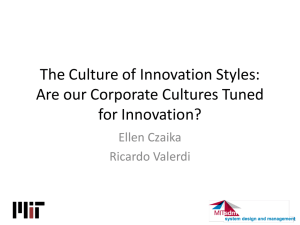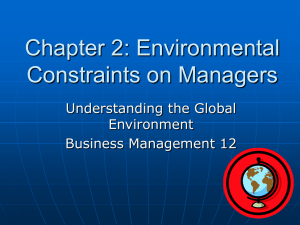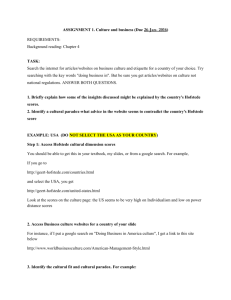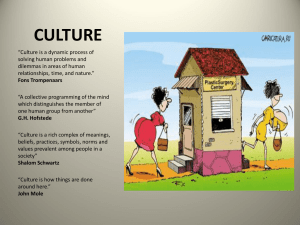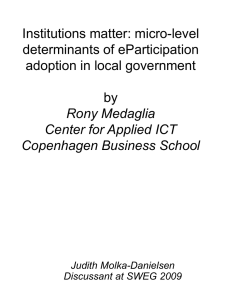The Culture of innovation Styles: Are our Corporate
advertisement
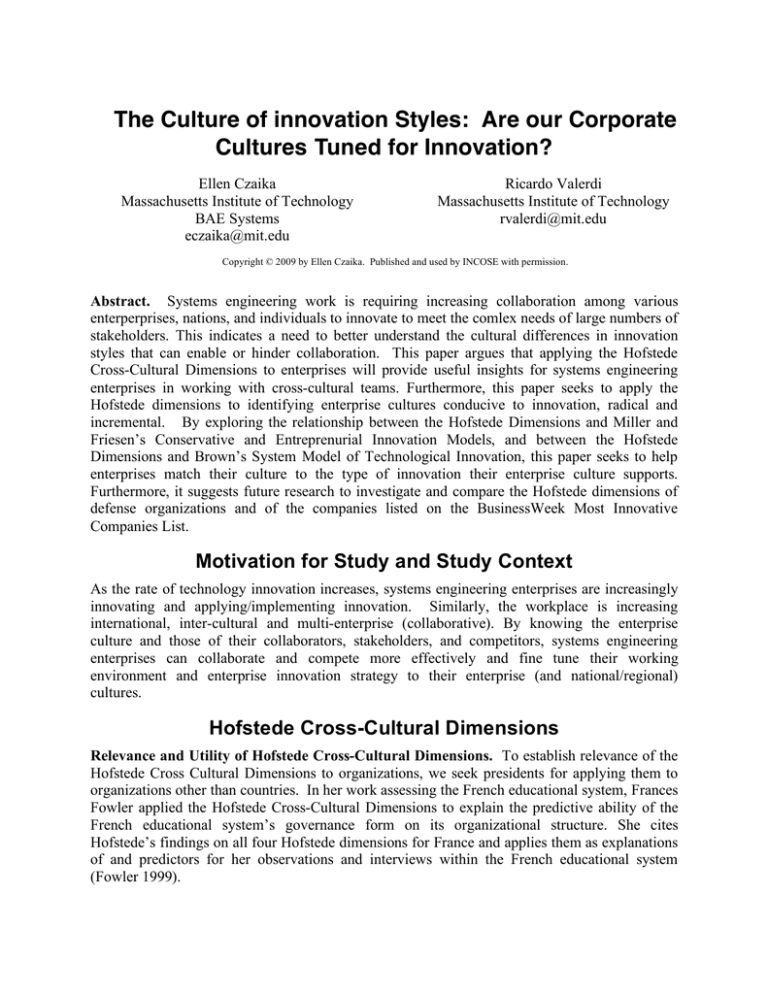
The Culture of innovation Styles: Are our Corporate Cultures Tuned for Innovation? Ellen Czaika Massachusetts Institute of Technology BAE Systems eczaika@mit.edu Ricardo Valerdi Massachusetts Institute of Technology rvalerdi@mit.edu Copyright © 2009 by Ellen Czaika. Published and used by INCOSE with permission. Abstract. Systems engineering work is requiring increasing collaboration among various enterperprises, nations, and individuals to innovate to meet the comlex needs of large numbers of stakeholders. This indicates a need to better understand the cultural differences in innovation styles that can enable or hinder collaboration. This paper argues that applying the Hofstede Cross-Cultural Dimensions to enterprises will provide useful insights for systems engineering enterprises in working with cross-cultural teams. Furthermore, this paper seeks to apply the Hofstede dimensions to identifying enterprise cultures conducive to innovation, radical and incremental. By exploring the relationship between the Hofstede Dimensions and Miller and Friesen’s Conservative and Entreprenurial Innovation Models, and between the Hofstede Dimensions and Brown’s System Model of Technological Innovation, this paper seeks to help enterprises match their culture to the type of innovation their enterprise culture supports. Furthermore, it suggests future research to investigate and compare the Hofstede dimensions of defense organizations and of the companies listed on the BusinessWeek Most Innovative Companies List. Motivation for Study and Study Context As the rate of technology innovation increases, systems engineering enterprises are increasingly innovating and applying/implementing innovation. Similarly, the workplace is increasing international, inter-cultural and multi-enterprise (collaborative). By knowing the enterprise culture and those of their collaborators, stakeholders, and competitors, systems engineering enterprises can collaborate and compete more effectively and fine tune their working environment and enterprise innovation strategy to their enterprise (and national/regional) cultures. Hofstede Cross-Cultural Dimensions Relevance and Utility of Hofstede Cross-Cultural Dimensions. To establish relevance of the Hofstede Cross Cultural Dimensions to organizations, we seek presidents for applying them to organizations other than countries. In her work assessing the French educational system, Frances Fowler applied the Hofstede Cross-Cultural Dimensions to explain the predictive ability of the French educational system’s governance form on its organizational structure. She cites Hofstede’s findings on all four Hofstede dimensions for France and applies them as explanations of and predictors for her observations and interviews within the French educational system (Fowler 1999). Applying Fowler’s logic that the Hofstede Cross-Cultural Dimensions are applicable to organizations other than countries, this study applies them to companies, firms and other organizations. The verifying the utility of the Hofstede Cross Cultural Dimensions to identifying innovation strategy is one subject of this study. The authors selected them because they measure multiple dimensions of cultural characteristics and some interactions of these dimensions. Other sociological and anthropological cultural models will also be explored in future research. Currently, they are an initial model serving as a starting place. Explanation of the Hofstede Cross-Cultural Dimensions. As he originally designed, Hofstede’s Cross-Cultural Dimensions characterize national cultures with positions on four two-ended spectrums. Combining a country’s/region’s position on each of the 4 dimensions gives a descriptive picture of the behaviours and attitudes of the nation/region. The Dutch sociologist Hofstede developed these dimensions within IBM, initially as an IBM employee himself. He conducted surveys (initially a 180-item survey) among IBM employees and expanded it to 66 counties and 88,000 respondents. The 4 dimensions are (please see Figure 1): Power Distance Index (PDI) which Hofstede defines as the level of acceptance of and the relative comfort with differences of power among individuals and hierarchical organizational structures. High Power Distance countries prefer to be lead by a “ benevolent autocrat or ‘good father’” (Fowler 1999) and (Hofstede 1991). Low Power Distance countries favour a democratic leader who deemphasizes the power distance (deemphasizes inequality) (Fowler 1999) and (Hofstede 1991). Hofstede compared countries’ PDI with other characteristics of the nation such as geographic latitude (a rough descriptor of climate), population size and wealth. The combination of the latitude (of the national capital), the population size and the per capita gross national product in 1970 predict 58 percent of the variance in PDI (Hofstede 1991). Masculinity-femininity (assertiveness-modesty) is the dimension that Hofstede describes as valuing outward success versus valuing human relationships and environment. Hofstede compared the various countries in his study of IBM employees and investigated the difference between men’s answers and women’s answers. This index is the only one on which men and women had a statistically significant difference. From the most feminine country to the most masculine country, men’s scores differed more than women’s (i.e. ignoring country, women’s scores were more homogeneous than men’s). In the most feminine countries, women and men scored identically. Men and women’s scores were the most different from each other in the most masculine countries. In some of the most masculine countries, women scored more masculine than men from less masculine cultures. Hofstede found no relationship between countries’ economic development and their masculinity-femininity index (Hofstede 1991). Uncertainty Avoidance is another dimension and is the amount of anxiety or threat caused by uncertainty and unknown situations. High Uncertainty Avoidance countries “emphasize rules, procedures, planning, and short-term feedback” (Fowler 1999). Their desire is a highly structured and predictable environment. Nations with high uncertainty avoidance tend to have a history of having been invaded, attacked, or defeated militarily and citizens have a high general level of psychological anxiety (Fowler 1999). In low Uncertainty Avoidance nations people reject rules and rigid procedures in favour of higher level, more abstract guidance (Fowler 1999). Low Uncertainty Avoidance countries enjoy relaxing, have a lesser need for busyness but can work hard when it is needed. Low Uncertianty Avoidance countries experience lower urgency and high Uncertainty Avoidance cultures experience higher urgency, comparatively. Hofstede clearly states that uncertainty avoidance is not the same as risk avoidance, citing examples of fast driving speeds in high uncertainty avoiding countires. The sense of urgency in these countries relates to faster driving speeds, which inherently contian greater risk of driving accidents and injury (Hofstede 1991). Individualism-Collectivism is defined as the valuation of the individual over the group or the group over the individual. Workers in individualistic countries want to advance their self-interest through challenging work. Countries falling into the collectivist end of the spectrum experience moral obligations to the group and prefer security, orderliness and group decisions (Fowler 1999) and (Hofstede 1991). Figure 1 Hofstede Cross Cultural Dimensions Interactions among the dimensions. Hofstede investigates two of the possible interactions among these dimensions, though he does not discuss all in his Cultures and Organizations: Software of the Mind as Fowler points out (Fowler 1999). Hofstede expounds on the interactions between masculinity-femininity and PDI and between PDI and UAI. He infers motivational patterns from the former and organizational forms from the later (Hofstede 1991). For countries with low uncertainty avoidance and low masculinity (high femininity), the motivating drives are sustaining relationships and maintaining a pleasant environment. For high uncertainty avoidance and low masculinity (feminity), workers are motivated by security and a sense of belonging to a group with personal wealth influencing less than cohesion in the group. In countries with high uncertainty avoidance and high masculinity, Hofstede indicates that individuals are motivated to achieve personal security through hard work and/or wealth. For countries with low uncertainty avoidance and high masculinity, the motivation is the chance for individual success, with money as the measuring stick (Fowler 1999). Please see Figure 2Figure 2. Figure 2 Hofstede Motivational Patterns (Fowler 1999) and (Hofstede 1991) The preferred organizational forms indicated by comparing Power Distance Index (PDI) and Uncertainty Avoidance Index (UAI) indicate that low PDI and low UAI countries prefer a market-like organization with relatively loose regulations. Low PDI and high UAI countries operate like “well-oiled machines” in what Hofstede terms a “workflow bureaucracy” (Fowler 1999) and (Hofstede 1991). Countries with a combination of a high PDI and a high UAI prefer what Hofstede terms a “full bureaucracy,” which has a rigid hierarchy supported by well defined rules and processes (Fowler 1999) and (Hofstede 1991). Hofstede notes that countries with a high PDI and a low UAI prefer a personal bureaucracy, where organizational structure determines the personal relationship, a “family” (Fowler 1999) and (Hofstede 1991). Please see Figure 3. Figure 3 Hofstede Preferred Organizational Forms (Fowler 1999) and (Hofstede 1991) Miller and Friesen Models of Innovation: Conservative and Entrepreneurial Relevance and Utility of Miller and Friesen’s Model of Innovation. Miller and Friesen categorize companies according to their innovation styles. They investigated and explain correlations between each innovation style and four categories of variables covering the business environment, information processing, organizational structure, and decision making. As explained above, the Hofstede Cross Cultural Dimensions Power Distance Index and Uncertainty Avoidance Index cross to identify four organizational forms/structures. The Miller and Friesen Model is relevant and useful because it ties innovation with organizational structure among other variables. Further evidence of the Miller and Friesen’s model relevance are the data used to establish it. Miller and Friesen’s data sample were 52 businesses ranging in size of sales from less than two million to over one billion United States dollars. These firms employed an average of 2,270 employees and are from industries including “retailing, furniture manufacturing, broadcasting, pulp and paper, food, plastics, electronics, chemicals, meatpacking, publishing, construction, and transportation” (Miller 1982). Their similarities are their geographical proximity to Montreal and that they represent the personal interests of MBA students (Miller 1982). Miller and Friesen claim sufficient dispersion in size and type of firm and overall sample balance (no firm type or size dominates) to produce generalizable results (Miller 1982). Miller and Friesen Models of Innovation in Conservative and Entrepreneurial Firms. Miller and Friesen turn to strategy as “a mediating influence in the relationships between innovation and its context” (Miller 1982). Miller and Friesen classify firms into two categories: conservative and entrepreneurial, deriving two models for innovation bearing these names. The Conservative Model, the more pervasive in literature on product innovation, implies that continuation of the existing situation (product) is the norm. That is, the conservative model sees innovation as abnormal, as brought about only by threats and challenges to the existing situation. Furthermore, innovation requires four components: the firm’s environment must present challenges/threats, decision makers must be aware of these challenges (through “scanning and control systems”), the firm must have the ability to innovate and the firm’s decision making structure must accommodate innovation and innovative products (Miller 1982). Thus, the amount of innovation and the number of environmental changes will increase and decrease together. The causality is inferred by applying the Miller and Friesen’s momentum phenomenon. That is, firms tend to continue on their evolutionary trajectory, potentially to destructive levels. In the case of conservative (innovation-avoiding) firms, they may avoid innovation until they stagnate (Miller 1982). Combining the observation that innovation and environmental changes are positively correlated and the momentum phenomenon, Miller and Friesen infer that for conservative firms, a rise in environmental changes spurs an increase in innovation, as these firms’ scanning and control systems (warning systems) detect strategic danger with continued innovation avoidance (Miller 1982). The Entrepreneurial Model applies to firms that regularly innovate and assume risks in their product-market strategies to do so. In these firms, innovation is paramount to their strategy and is considered inherently good. Whereas conservative firms needed external stimulus to begin innovating, entrepreneurial firms need external stimuli to stop. These external stimuli are made known to leadership through “scanning and control” systems. Internal firm analysis of decisions, future-viability, the external environment, and strategic considerations form internal checks to keep innovation from reaching wasteful or excessive levels. As such, strategy is a larger driver of innovation than environmental challenges or threats for entrepreneurial firms and their innovation may create environmental challenges/threats for other firms. Therefore, innovation and environmental challenges/threats will likely still reinforce each other, though the causality may be unclear. Furthermore, since strategy drives the innovation frequency, a lesser positive correlation is expected between organizational structure and innovation in entrepreneurial firms than in conservative firms. Brown Systems Model of Technological Innovation Relevance and Utility of the Brown Systems Model of Innovation. Brown does not indicate a dataset employed in creation of the Systems Model other than a coalescence of existing innovation literature. Furthermore, he notes the concern about the “competence of American industrial managers to develop and maintain an efficient internationally competitive flow of technological innovations” (Brown 1989). Brown targeted his paper at increasing innovation in organizations; therefore this study assumes relevance and utility. The Brown Systems Model of Innovation. The Brown Model synthesizes innovation research through a systems model. This model divides the inputs to innovation into decision inputs and implementation inputs. The former control and influence the behavior of the later through processes. Further upstream, the corporate strategy influences the decision inputs (Brown 1989). Brown breaks the decision inputs into categories: overall company strategy, company technology strategy and the values of company leaders. The strategy includes the company’s plans for addressing external opportunities and threats, which include abruptly occurring technological developments. The technological policy of a company pairs with its strategy to address the amount of technological risk the company wishes to assume, the types of technology programs desirable to pursue, planning for technological obsolescence, and the company’s split between partnerships with other organizations on technological matters and internal development, and the company’s competitive new product development inclinations. Brown summarizes the literature in the field relating to leader values citing three different authors who discuss different aspects. Ettlie and Bridges discuss the relationship between technology policy and managerial values, that the policy “embodies the innovative attitudes and values of the top management” (Brown 1989) and (Ettlie 1982). Hage and Dewar find that an organization’s innovative level is predicted by its management values (Brown 1989) and (Hage 1973) and Kelly discusses the necessity of management support for success in innovation (Brown 1989) and (Kelly 1976). In discussing the Implementation Inputs, Brown indicates that “the organizational structure, the quality of information flow, the relevant manpower flows and the specification of key roles for innovative action” are all essential for successful innovation implantation (Brown 1989). The relationship between organizational structure and innovation has long been described as more flexible organizational structures benefitting radical innovation and more structured, systematic organizational structures fostering implementation activities required to realize innovative ideas into products. Brown segregates information flows into two categories: externally originating information entering the organization by passing through “boundary-spanners” and information conveyance within the company [presumably externally originating information becomes internally-conveyed information after it has successfully been internalized] (Brown 1989). However, Brown cautions that moving information alone is not sufficient for successful innovation, but must be supplemented with the manpower flows of moving individuals among organizational units. Brown implies that the importance in moving personnel is as an efficient means of moving information (Brown 1989). Eric von Hippel terms this “information stickiness” and indicates that although employees have information about solutions, it is the technology users (customers) who have information about their needs. von Hippel continues differentiating between user and manufacturer information by noting that users have more intimate knowledge of their use context and needs, and therefore tend to develop more feature-rich innovations specifically meeting their needs whereas companies (manufacturers) possess information about implementation innovations (von Hippel 2005). Brown continues describing how company employees and information relate by suggesting there are necessary personnel roles conducive to innovation: “1) gatekeeping, 2) idea generating, 3) project championing, 4) project management and 5) sponsorship by senior management” (Brown 1989). Although Brown does not make the connection explicitly, the careful reader infers that each of Brown’s “key roles” (Brown 1989) specializes in a type or types of information as he describes it. That is, gatekeepers specialize in brining external information into the organization. Idea generators combine this external information with their internal knowledge to create ideas. Project champions recognize these new ideas, sort through them and identify viable options using their external and internal knowledge. Project Managers specialize in employing their internal knowledge to bring these ideas into existence and senior managers combine their external and internal knowledge to support the innovation. Brown continues by characterizing strategic choices into three “competitive modes: 1) an emphasis on the development of radically new products, 2) an emphasis on the development of incrementally new products, and 3) an emphasis on process innovation and efficiency (Brown 1989) [emphasis in original text]. Brown’s category “radically new products” may in some cases also be Clayton Christensen “disruptive innovations” and Brown’s “incrementally new products” may in some cases also be Christensen “sustaining innovation” (Christensen 2003). Brown maps these strategic choices into company organizational structure with smaller entrepreneurial firms excelling at radical innovation (first-to-market) and larger organizations succeeding at the process improvements and fine-tuning technologically advances necessary for incremental innovation (Brown 1989). Utterback explores the case where large firms enter markets new to them. Furthermore, the Utterback model of dynamics of innovation among multiple productive units in the same market segment notes that the number entrance and exits of firms to a particular market parallel the innovation in that market/industry (Afuah 1991). After establishing the innovation system, Brown addresses forces that resist and favor innovation. Resisting forces are most detrimental in the stimulation and idea generation phases of the innovation process [Brown defines the innovation process as 1) stimulation, 2) idea generation, 3) proposal selection and funding, 4) problem solving, and 5) output realization] because they impede the information flow (Brown 1989). He lists factors including organizational structure, an organizational structure ill suited for acquisition of the new information, impurities contaminating the information or ineffective information filters, organizational rigidity preventing adequate response to the information, and organizational bias (Brown 1989). Brown lists factors favoring innovation that exist in the “values, commitment, motivation, and past experiences of individuals who are responsible for carrying out innovative activities in the organization and partner with innovation-conducive organizational incentives (Brown 1989). Brown closes by indicating that the management values impact the innovation process through the mechanistic functions of proposal selections and budgeting allocations and by establishing a climate for innovation (or not). Brown briefly describes this “climate for innovation” as incentive policies, reward allocations, performance measurement and personnel selection (Brown 1989). However, he does not describe what characteristics of each of these values support innovation and which are detrimental to it. Please see Figure 4. Figure 4 The Brown Systems Model of Innovation Comparison of Hofstede Cross-Cultural Dimensions to the Miller and Friesen Models of Innovation and to the Brown Systems Model of Innovation This paper explores the relationship between the Hofstede Cross-Cultural Dimensions that relate to Miller and Friesen’s conservative and entrepreneurial firms and to Brown’s Systems Model of Innovation. The most relevant Hofstede Cross-Cultural Dimensions are expected to be uncertainty avoidance index, power distance index. Brown suggests that the company strategy, its technology policy and the values of the firm’s highest leaders determine the firm’s technological innovation. That is, Brown combines the role of strategy (pertinent to the Miller and Friesen Innovation Models) and policy descriptions and leadership attitudes (relevant to the Hofstede Cross-Cultural Dimensions) as indicative of innovation level (Brown 1989). It is expected that firms ranking low on the uncertainty avoidance index will exhibit the Miller and Friesen entrepreneurial tendency of having strategically driven innovation. Likewise, firms with high uncertainty avoidance values are expected to be similar to Miller and Friesen’s conservative firms. However, more complex interactions may make this mapping less clear. Furthermore, the Hofstede Motivational Patterns (created by interacting the Uncertainty Avoidance Index and the Masculinity-Femininity Index) may indicate an organization’s inclination on the Miller and Friesen Innovation Models. That is, organizations motivated by individual success and advancement (high masculine and low uncertainty avoidance) may fit the Miller and Friesen Entrepreneurial model. It is unclear whether the uncertainty avoidance index value or the masculinity-femininity index drives the motivation for innovation, that is whether the quadrant low masculinity and high uncertainty avoidance or the quadrant high masculinity and high uncertainty avoidance represents Miller and Friesen’s conservatively innovative organization, or both. A Culture for Innovation. Hofstede contends that low UAI countries are more likely to stimulate basic innovations as they maintain a greater tolerance towards deviant ideas. On the other hand they seem to be at a disadvantage in developing these basic innovations towards full-scale implementation, as such implementation usually demands a considerable sense of detail and punctuality. The latter are more likely to be found in strong uncertainty avoidance countries. The UK [low uncertainty avoidance (ranked 48 out of 53)] has produced more Nobel Prize winners than Japan [high uncertainty avoidance (ranked 7 out of 53)], but Japan has put more new products on the world market (Hofstede 1991). Using Hofstede’s assessment includes the assertion that bringing innovative products/systems to market includes both generating and developing the ideas, characteristics he puts at opposite ends of his Uncertainty Avoidance Index spectrum. Therefore, one might infer that firms that are moderate at each of generating and developing ideas, but competent at both would bring the most innovative products to market. Miller and Friesen’s model could house these firms as either conservative firms that have efficient scanning and control systems to assess the environmental urgency for innovation or as entrepreneurial firms with oppositely functioning scanning and control systems that monitor the effectiveness of their continued innovations and match them to market/environmental viability. Different levels of the Hofstede Cross-Cultural Dimension relate to Brown’s suggested organizational models for radically new products and for incrementally new products. For radically new innovation, organizations motivated by individual success and advancement (high masculine and low uncertainty avoidance; Quadrant 4 in Figure 2) may be better suited. Similarly, those motivated by personal security (high masculinity and high uncertainty avoidance; Quadrant 3 in Figure 2) may map to Brown’s incremental innovators. Similarly, firm organizational structures that follow Hofstede’s Village Market Place (low power distance index and low uncertainty avoidance index; Quadrant 1 in Figure 3) parallel Brown’s radically innovating company descriptions. The mapping to Brown’s incremental innovators is less clear. Perhaps either Workflow Bureaucracies (low power distance index and high uncertainty avoidance, Quadrant 2 on Figure 3) or Full Bureaucracies (high power distance index and high uncertainty avoidance index, Quadrant 3 on Figure 3) provide the necessary procedural structure for incremental innovation. Future Research. Assessing organizations of the United States defense industry and some firms from the BusinessWeek most innovative list for their Hofstede cross-cultural dimensions may reveal patterns among defense industry organizations, among innovative firms and potentially between the defense industry and the BusinessWeek group of innovative firms. Likewise, assessing these groups for their Miller and Friesen Innovation Model and their adherence to the Brown Systems Model may reinforce or refute any potential patterns discovered with the Hofstede analysis. Additionally, investigating whether and how the Hofstede Cross Cultural Dimensions fit with the Utterback and Abernathy Dynamic Model of Innovation, the Utterback and Kim model of discontinuous change in a product, and the Utterback Model of dynamics of innovation among multiple productive unites in one industry will be insightful. Utterback discusses characteristics of organizations successful in each of the Utterback and Abernathy model’s three states: fluid, transitional, and specific (Afuah 1991). Many of the descriptors of these characteristics are similar to dimensions measured by the Hofstede Cross Cultural Dimensions. Implications and Expected Results Systems engineering firms can use understanding of their enterprise culture and that of their teammates, stakeholders and competitors to meet complex stakeholder needs more effectively and to identify market opportunities and risks. By architecting an enterprise structure, communication channels, and strategy according to the enterprise culture, these enterprises increase the likelihood of implementing their strategy. Furthermore, as the environment changes around them with an ever accelerating rate of new technology development, systems engineering enterprises may need to improve their scanning and control systems to monitor the environment for opportunities for innovation, and to tune their approach to innovation identification and development to their individual enterprise cultures. By using their Hofstede Cross-Cultural Dimensions to create organizational structures supportive of their preferred working structure and to innovation (engendering of innovation), these organizations may be able to regulate the balance of innovation and sustained strategy/products for the enterprise as a whole and/or for groups within the enterprise. That is, by structuring the decision making authority in concert with the organization’s quadrant on Hofstede’s power distance index and the uncertainty avoidance index, organizations may be able to create internal trust for decisions, and by creating tools or systems of environmental monitoring and assessment, they may equip these decision makers with tools to match innovation strategy to enterprise culture and to tune the level of innovation to the market/environment for both incremental and radical innovations. Additionally, organizations/enterprises may discover that to adjust to the changing innovation phases within their industry, they may need to change the leadership, focus, strategy, staff/employees, and organizational structure of their entire organization or of parts of it. This may be particularly difficult for enterprises Miller and Friesen classify as conservative. But, all enterprises may find their optimal approach is to sense the environment within their industry and the technologies related to it (continually taking in external information for strategy formation), and to adjust themselves accordingly. References Afuah, A. and J.M. Utterback. "Emergence of a New Supercomputer Architecture." Technological Forecasting and Social Change, vol 40, 1991: 315-328. Brown, W.B. and N. Karagozoglu. "A Systems Model of Technolgoical Innovation." IEEE Transactions on Enginering Management, Vol 36, No.1, February 1989, 1989: 11-16. Christensen, C.M. and M.E. Raynor. The Innovator's Solution: Creating and Sustaining Successful Growth. Boston: Harvard Business School Press, 2003. Ettlie, E.J. and W.P. Bridges. "Environmental uncertainty and organizational technology policy." IEEE Trans. Eng. Manag., vol EM-29, no1, 1982. Fowler, F.C. "Applying Hofstede's Cross-Cultural Theory of Organizations to School Governance: A French Case Study." Reports - Comparative and International Education Society Conference. Toronto: Comparative and International Education Society, 1999. 1-35. Hage, J. and R. Dewar. "Elite values versus organizational structure in predicting innovation." Admin. Sci. Quart., vol 18, 1973. Hofstede, G. Cultures and Organizations: Software of the Mind. London: McGraw-Hill Book Company, 1991. Kelly, G. "Seducing the elites: The politics of decision making and innovation in organizational networks"." Acad. Manag. Rev., 1976: 66-72. McGregor, J. The World's Most Innovative Companies; Businessweek. April 17, 2008. http://images.businessweek.com/ss/08/04/0417_mostinnovative/index_01.htm (accessed Nov 10, 2008). Miller, D. and P.H. Friesen. "Innovation in Conservative and Entrepreneurial Firms: Two Models of strategic Momenetum." Strategic Management Journal, Vo 3, No 1. (Jan.-Mar., 1982), 1982: 1-25. von Hippel, E. Democratizing Innovation. Cambridge: The MIT Press, 2005. BIOGRAPHIES Ellen Czaika is enrolled in the Massachusetts Institute of Technology (MIT)’s System Design and Management (SDM) Masters’ program. She is simultaneously working full time at BAE Systems as a Systems Engineering Specialist and Functional Manager Level1. She has an MSc in Applied Statistics from Oxford University and a B.S. in mathematics from Millsaps College. She has worked in the systems engineering field for 9 years. Ricardo Valerdi is a Research Associate in the Lean Advancement Initiative and a Lecturer in the Engineering Systems Division at MIT. He is also the co-founder of the Systems Engineering Advancement Research Initiative (SEAri). He received his B.S./B.A. in Electrical Engineering from the University of San Diego in 1999, and his M.S. and Ph.D. degrees in Systems Architecting and Engineering from USC in 2002 and 2005. He is the author of over 45 technical publications which have appeared in IEEE, AIAA, and INCOSE conferences. His work has appeared in several journals, including Journal of Systems Engineering, Journal of Systems and Software, and CrossTalk - The Journal of Defense Software Engineering. He is a member of the Board of Directors of INCOSE and current Treasurer.
